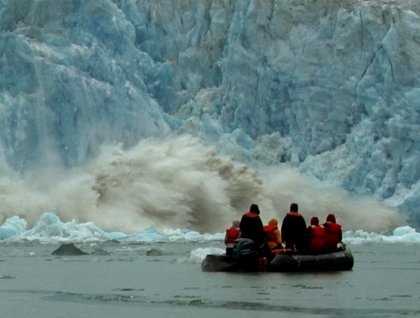We awoke cruising through the photographs and drawings of textbooks on glacial geology. Our ship passed truncated spurs of ridges that long ago were hewn through to make room for the glacier that once filled this channel. Perfectly U-shaped valleys hung on the canyon walls above us, and horn-like peaks towered high in the distance having been sculpted by other glaciers tearing their slopes away. Cascading waterfalls dropped off the high canyon walls and stepped their way downward to spill into the seawater within Tracy Arm.
A fjord that has been cut in extremely hard and resistant rock later becomes an oracle for anyone who chooses to read it. It’s the story of a giant, one that uses the weight of over 5000 feet of ice bearing down on rock tools to press hard and carve its bed. The resulting forces gouge and crush long depressions and shatter whatever is in their way. The ice removes the waste, and transports it far away, leaving a fastidiously clean surface. It is of great fortune for us to be able to see the immaculate results of gravity, ice and time here in this wilderness.
We explored this extraordinary cathedral in our expedition landing craft. The glacial face grew taller and then gigantic as we approached. Loud cracking sounds like gunshots echoed in the canyon walls. It was still difficult to believe that the face of South Sawyer Glacier was the height of a 20-story building until we saw massive blocks of ice topple down and smash into the sea. Later we became spellbound when a section 400 feet wide and the full height of the face crumble, causing a surging wave to erupt out of the glacier’s base and spread as an advancing arc at least 20 feet high. Ice bobbed and churned as the wave moved closer. Fortunately its short-lived energy dissipated before it reached us.
Two representatives of the Forest Service in kayaks joined us and gave a friendly talk about this dynamic wilderness area and their jobs here. During the afternoon we motored back through Tracy Arm and watched hundreds of waterfalls tumbling down the walls of the fjord.
Williams Cove is a great place to hike, so we headed for shore for our first in-depth look at a Southeast Alaskan rain forest. Some also struck out in sea kayaks to explore from the water. The constant rain had filled all of the creeks as well as the trails. We felt that we had not only experienced the rain forest and its associated natural history, but also the deluge that makes this place what it is. We were soon all back on the National Geographic Sea Bird enjoying all the comforts of our warm, dry ship.









